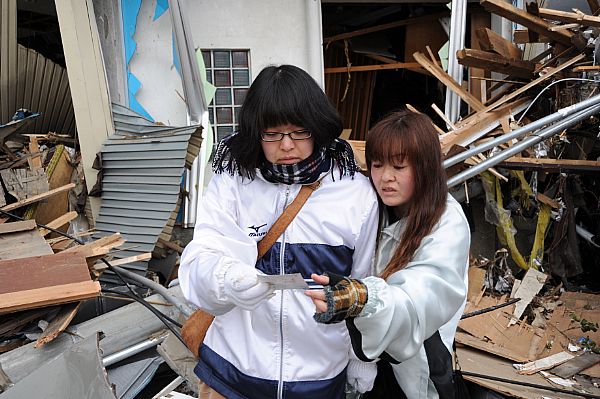
A mother and daughter look at a family photo amid the wreckage of their home in Ofunato, Japan. (U.S. Navy photo by Mass Communication Specialist 1st Class Matthew M. Bradley.)
By Ralph De La Cruz
Florida Center for Investigative Reporting
I had planned to take up the issue of immigration today. But with the disaster that has been unfolding in Japan, nuclear power and emergency preparation move to the forefront.
The events in Japan, where an unbelievable chain of natural disasters has caused a nuclear emergency in up to six reactors, beg the question: Is Florida ready?
After all, as residents of a peninsula that sticks out into hurricane alley, we face the possibility of unbelievable natural disaster every year.
Related Story |
And we live in a state that has three nuclear power plants and five reactors. And a fourth plant sits in Alabama, near our northern border.
Two of our plants — Turkey Point and St. Lucie — sit on the Atlantic coast, which means they are exposed to the possibilities of hurricanes and, yes, even tidal surge from a monster hurricane or the rare tsunami.
Turkey Point is in Miami-Dade, the most populous county in the state. St. Lucie is in the booming treasure coast.
The good news is that the two plants have already survived some tough hurricanes. Killer Hurricane Andrew came ashore near Turkey Point in 1992, and Hurricanes Frances and Jeanne hit near St. Lucie in 2004. Of course, the bad news is that the two plants have been through some tough hurricanes. As any Florida homeowner will tell you, hurricanes don’t strengthen structures.
The third nuclear power plant, in Crystal River, is near the Gulf Coast along Florida’s coastal bend. If you don’t live in the area, you might not be aware that the 34-year-old Crystal River plant has been offline for 18 months due to cracks in the 42-inch concrete skin that reinforces an interior layer of steel.
As Japan has shown, disasters do not always unfold the way we expect.
Just as the Japanese were prepared for the earthquake but waylaid by the tsunami, we may be prepared for the hurricane but ill-prepared for, say, a massive tidal surge. Or even a wildfire. The unpredictable is what turns disaster into catastrophe.
All three of Florida’s nuclear power plants are in coastal areas, where water tables are shallow. Which means a failure in containment could contaminate ground water.
Should we be concerned? You tell me.
A survey of state epidemiologists and health departments that was conducted last summer and released Monday by the Council of State and Territorial Epidemiologists had some sobering news.
“Results of this assessment indicate that in most measures of public health capacity and capability, states are poorly prepared to adequately respond to a major radiation emergency event,” the report stated.
Thankfully, Florida seems to have a fairly comprehensive plan in place.
And on Monday, Gov. Rick Scott ordered a review of the state’s preparedness for a nuclear disaster.
“The information I’ve received shows that across state agencies, in conjunction with federal partners and utility operators, we are prepared for an effective and rapid emergency response,” Scott said.
Hopefully we won’t look back at that as Scott’s “Brownie, you’re doing a heckuva job” moment.
This is another example of why our sudden tea party-driven, cut-at-all-costs obsession is so dangerous. The unexpected and seldom-used is an easy target for the budget ax.
For example, the U.S. House of Representatives wants to cut 30 percent from the National Weather Service. Folks in Hawaii are concerned that the Pacific Tsunami Warning Center could be shut down for a month each year. Considering our geography, we should be equally worried.
Scott has proposed keeping the Division of Emergency Management’s budget intact for 2011-12 with $241 million. But his 2012-13 budgets shows a proposed cut of $93 million — more than a third of the division’s budget:
| FY 2011-12 | FY 2012-13 | |
| From General Revenue Fund | $25,139,756 | $17,344,641 |
| From Trust Funds | $216,453,849 | $131,183,146 |
| Total Positions | 128 | 128 |
| Total All Funds | $241,593,605 | $148,527,787 |
By contrast, economic development programs and projects show an increase from $353 million to $553 million.
We can only hope that the lessons of Japan will still be remembered in the next legislative session.
